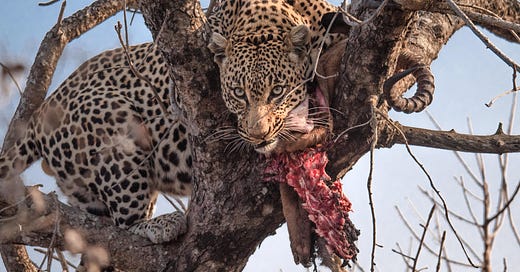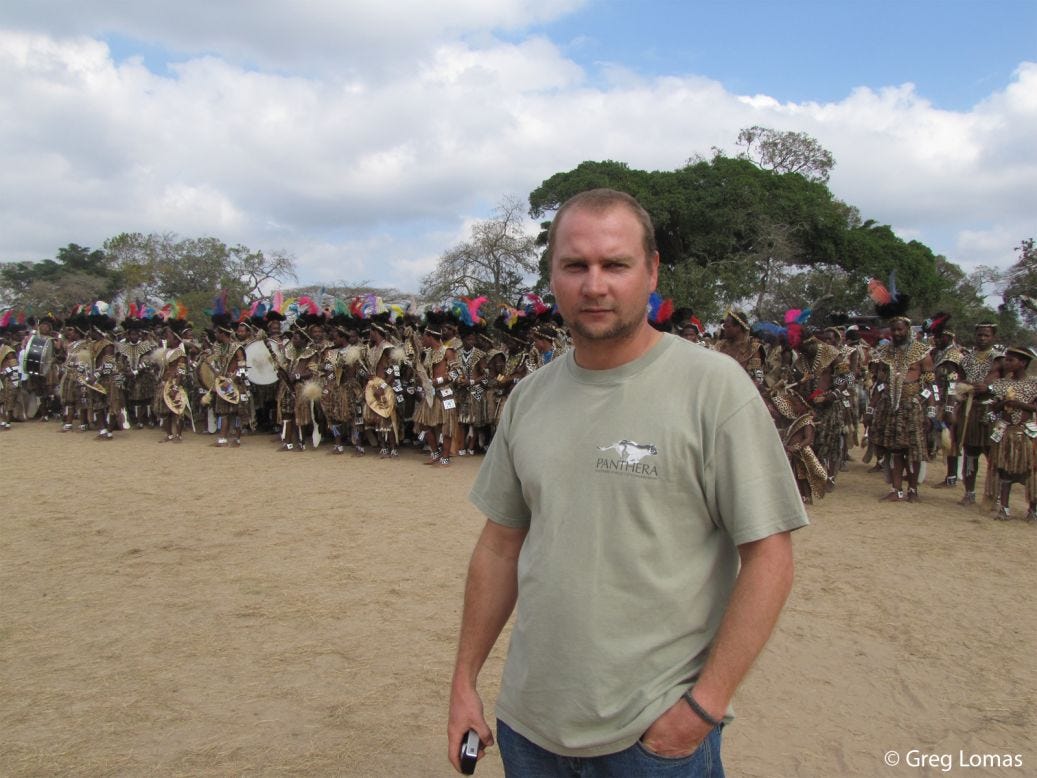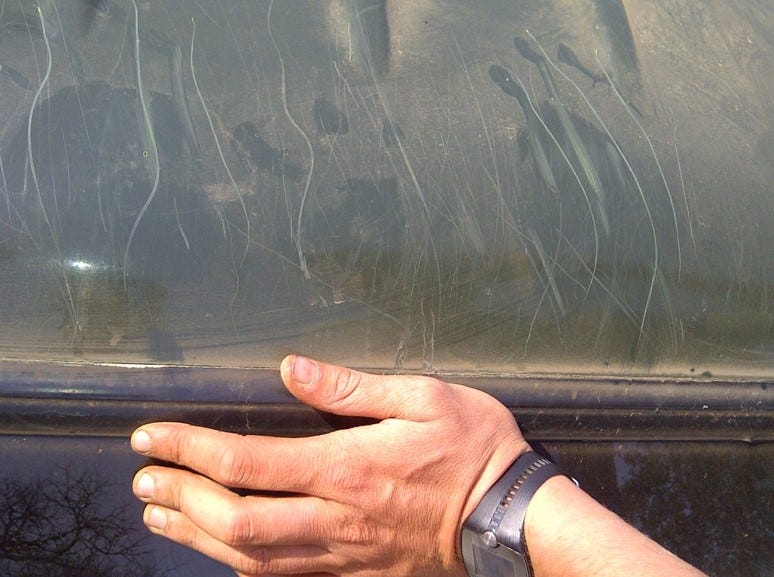by Richard Conniff
One of the great things about traveling on assignment to write about wildlife is that you hear some crazy stories. And one of the frustrating things is that they often don’t fit into the story you’re working on. So I was in Kwazulu-Natal, on the east coast of South Africa, for a National Geographic story about leopards. And I was writing about work by Tristan Dickerson, a leopard specialist for the global cat conservation organization Panthera. Panthera’s Furs for Life leopard program produces highly realistic fake leopard skins for use by religious groups who otherwise wear real leopard skins for ritualistic attire. The fake furs are a tool to reduce the needless killing of a threatened species. But along the way, Tristan started telling me about an entirely unrelated incident. Here’s the transcript of my recording, with minor edits for clarity. A few things to keep in mind: The leopard, a young male, was probably striking out from his birthplace to find a new territory of his own. A baakie is the Afrikaans term for a pickup truck, a bonnet is the hood, and in South Africa, the driver is on the right side of the car. Here’s Dickerson:
Okay, I'll give you the whole story. It's a little bit long … So I got called by the conservation authority veterinarian who said that there was a leopard stuck between two fences. It had already attacked some people, and [the veterinarian was too far away to get the scene in time]. With all my experience, could I go and dart this leopard and possibly catch it and remove it from this position?
Now, between these two fences was a district road, so cars needed to travel on this road. However, with the leopard being so stressed, the first vehicle that went down was a construction vehicle with people on the back, and the leopard climbed on the vehicle and pretty much emptied it of all the people … you know, under the conditions of being trapped between these two fences.
I have seen this with a leopard before. Sometimes when they cross a fence and they get a really bad shock from the fence, it shoots them through, and then they’re too scared to try to cross the fence again. So they they are literally trapped between these two fences. Unfortunately, in South Africa, unlike the States, you know, all of our reserves are fenced. So we have these weird scenarios where a road splits a nice, big game reserve, and on each side of that road we have to have a fence. So that's the circumstances.
I knew I was going into a dangerous situation, obviously, with people already being attacked. So I took a closed vehicle. Normally, I do all my work in an open game drive vehicle, you know, with no roof, no doors. But I decided to take a closed vehicle, knowing that this leopard is probably going to attack us.
When I arrived, I looked down the road. Now there were vehicles that closed off about four kilometers of this road. The leopard was somewhere along that stretch, and the vehicles were backing up. So I went in, and right in front, I could see where there was hats and shoes and a shirt, where, obviously this leopard had gotten the vehicle and pulled these people off. They all survived. It was just, the leopard was stressed, so it just gave a couple hits with the paws and then shot off, you know.
So I drove down, and after about five minutes, I found this leopard in one corner, but it was extremely nervous, lying flat on the ground, and it was in long grass. I couldn't get a dart in, moving backwards and forwards. And I had Alex in the car, who … just started working for me. He was a … young research assistant, so the poor guy was terrified. So I found the leopard but couldn't get a dart in because of the position ... And then the leopard started running down the road … It was just staying about 50 meters in front of me. It wouldn't let me get close enough for a dart, so I drove, drove up to it very fast, to put pressure on it. So it dived into the grass on the lefthand side to try and avoid me.
I turned hard right, put my nose against the fence on the righthand side. [And aiming] across Alex, the assistant, who had his window open just enough, I managed to get a dart off, and as the dart hit the leopard, its ears went flat and it just charged us.
Luckily, we’d practiced winding up the windows before, and Alex wound up the window on this leopard. I thought it was going to come and smash the window. I was worried it would get in, but it turned for some reason, and went for the front of the cart, hit the front of the car, and kind of went between the front of the car and the fence, where we couldn't see it. We just saw the shaking of the fence.
And then all of a sudden, this leopard launched over the bonnet of the car, onto the bonnet, onto the roof, and into the back of the … it was a baakie, a pickup truck … and jumped out the back and ran off. And you know, we were very shaken. I was actually concerned with the speed it was coming that it would just literally come right through the windscreen. So it ran off across the road and hid behind grass. So we left it. We didn't want to go near this thing … I knew I'd got a dart in. We just had to wait nine minutes, which is the time it takes …
After nine minutes, I drove up slowly, and I could just see the top of the leopard, and I could see the leopard was actually [caught in] the fence. So I jumped out of the car and ran up to it. And what had happened is, in this panicked state, it had tried to push through the fence and got its head stuck in the fence … but then succumbed to the drugs, with its neck through the fence, so it actually got suffocated.
So I ran up to pull the fence apart and pulled it out, and as I pulled it out, it just let out its last breath. Its eyes were just sunken into the back of its head, and it was dead. It wasn't breathing whatsoever.
So the only thing I could think of was to to give it resuscitation, and I started giving it mouth-to-nose a couple breaths, and then giving it hard compressions. I wasn't sure if it had a pulse or not. I just immediately started giving it oxygen and compressing and after just a couple goes, maybe five mouth-to-nose followed by compressions, I just stopped to give it a chance.
And I looked, and I looked, and immediately, its eyes were looking straight back into mine, and then I knew, you know, that it had come through this, this unconscious state, or nonbreathing. I looked, and it had very shallow breaths, and then it took a big, deep breath, and then it was breathing again, normally.
So, I mean, I didn't even think it was going to work … We were jumping around. We were so happy that it didn't die.
We then took it, put it into the game reserve, and watched it for two hours, and it woke up and ran off like nothing had happened.
So a very fortunate scenario. People are always telling me, “It's amazing. You saved a leopard.”
I tell them, “Well,, I actually killed it also. So it's a bit of a draw.”
And that's the that's the scenario in a nutshell, how it ended, without us being harmed, or the leopard.
HEAR THE INTERVIEW! As a special bonus for paid subscribers, I’m including the complete recording in a separate post.
UPDATE: Tristan sent this photo of what the claws of a panicked leopard do to the bonnet (hood) of a game drive vehicle:







Great story Richard! Thanks for sharing it.